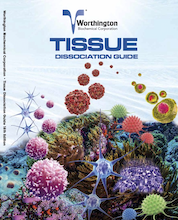For our international customers, please be advised that orders cannot be placed through our website by customers in countries with International Distributor representation.
Worthington Tissue Dissociation Guide
Methods and Materials: Working With Enzymes
All of the enzymes Worthington offers for tissue dissociation applications are available as lyophilized powders for convenience, versatility, and stability. As such they may be stored at 2 - 8°C, and they can be shipped without special handling. While lyophilization makes shipping and storing the enzymes easier, special care is required when opening any of the vials.
Lyophilized proteins tend to be very hygroscopic so they should not be opened in humid areas. Be sure that any vial has been brought to room temperature before opening. Ideally, the vials should be taken from the refrigerator at least a half hour before opening, and they should be left in a dessicator. Before opening any of the vials, be sure it is not at all cool to the touch. All of the cell isolation enzymes cited in this section can be repeatedly warmed to room temperature and then returned to the refrigerator as long as these precautions are followed.
Once diluted with media or buffer, proteolytic enzymes can undergo autolysis. Dissolve enzymes immediately before use.
Special care must be taken with deoxyribonuclease (DNASE). This product is very prone to shear denaturation. Mix gently.
Reconstituted enzymes should not be stored at 2 - 8°C. If necessary they can be aliquoted and frozen at -20°C. Avoid repeated freeze-thaw cycles.
All enzymes, upon reconstitution, can be sterile filtered through a 0.22 µm pore size membrane.
Generally most of the enzymes used in cell isolation procedures (except trypsin) can be directly dissolved in a balanced salt solution or buffer of choice. Stock solutions of trypsin should be made initially by reconstituting the enzyme in 0.001 N HCl. This solution can be diluted into the digestion medium or buffer immediately prior to use.
The compilation of standard balanced salt solutions with their references found in the following table can be helpful in selecting an appropriate dissociation solution.
| Ringer(c) | Tyrode (de) |
Gey(f) | Earle(g) | Puck(h) | Hanks(l) | Dulbecco (PBS)(jk) |
|
|---|---|---|---|---|---|---|---|
| NaCl | 9.00 | 8.00 | 7.00 | 6.80 | 8.00 | 8.00 | 8.00 |
| KCl | 0.42 | 0.20 | 0.37 | 0.40 | 0.40 | 0.40 | 0.20 |
| CaCl2 | 0.25 | 0.20 | 0.17 | 0.20 | 0.012 | 0.14 | 0.40 |
| MgCl2•6H2O | 0.10 | 0.21 | 0.10 | 0.10 | |||
| MgSO4•7H2O | 0.07 | 0.10 | 0.154 | 0.10 | |||
| Na2HPO4•12H2O | 3.00 | 0.39 | 0.12 | 2.31 | |||
| NaH2PO4•H2O | 0.05 | 0.125 | |||||
| KH2PO4 | 0.03 | 0.15 | 0.06 | 0.20 | |||
| NaHCO3 | 1.00 | 2.27 | 2.20 | 0.35 | |||
| Glucose | 1.00 | 1.00 | 1.00 | 1.10 | 1.00 | ||
| Phenol Red | 0.05 | 0.005 | 0.02 | ||||
| Atmosphere | air | air | 95%air/ 5%CO2 |
95%air/ 5%CO2 |
air | air | air |
| a | Amounts are given as grams per liter of solution |
| b | In some instances the values given represent calculations from data presented by the authors to account for the use of hydrated or anhydrous salts |
| c | S. Ringer, J. Physiol. (London) 18, 425 (1895) |
| d | M.V. Tyrode, Arch. Int. Pharmacodyn. Ther., 20, 2025 (1910) |
| e | R.C. Parker, Methods of Tissue Culture, 3rd ed., p. 57, Harper, New York, 1961 |
| f | G.O. Gey and M.K. Hey, Am J. Cancer, 27, 55 (1936) |
| g | W.R. Earle, J. Natl. Cancer Inst, 4, 165 (1943) |
| h | T.T. Puck, S.J. Cieciura, and A. Robinson, J. Exp. Med. 108, 945 (1958) |
| i | J.H. Hanks and R.E. Wallace, Proc. Soc. Exp. Biol. Med., 71, 196 (1949) |
| j | PBS, phosphate-buffered saline |
| k | R. Dulbecco and M. Vogt, J. Exp. Med., 99, 167 (1954) |
Tissue Tables
The Worthington Tissue Tables provide references useful to researchers interested in tissue dissociation and cell harvesting procedures. The references are organized by Tissue and Species type and linked to PubMed citations. The Cell type, Enzymes, and Medium for each reference is provided.
To search by specific criteria, use the Tissue References Search Tool.
